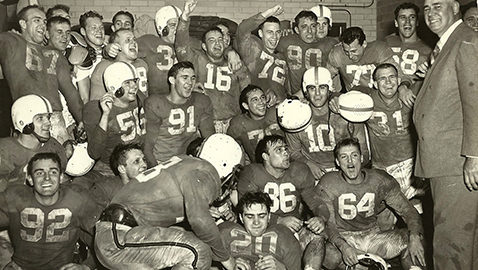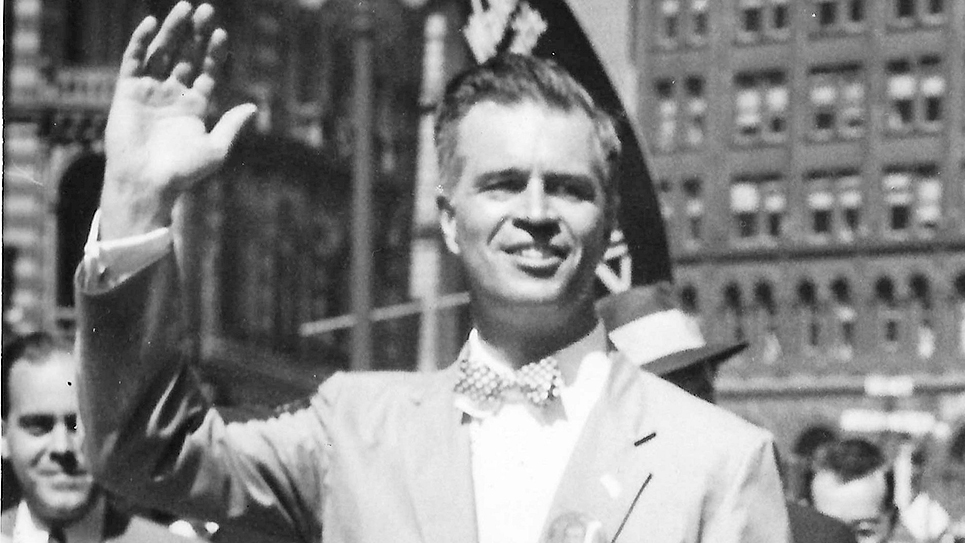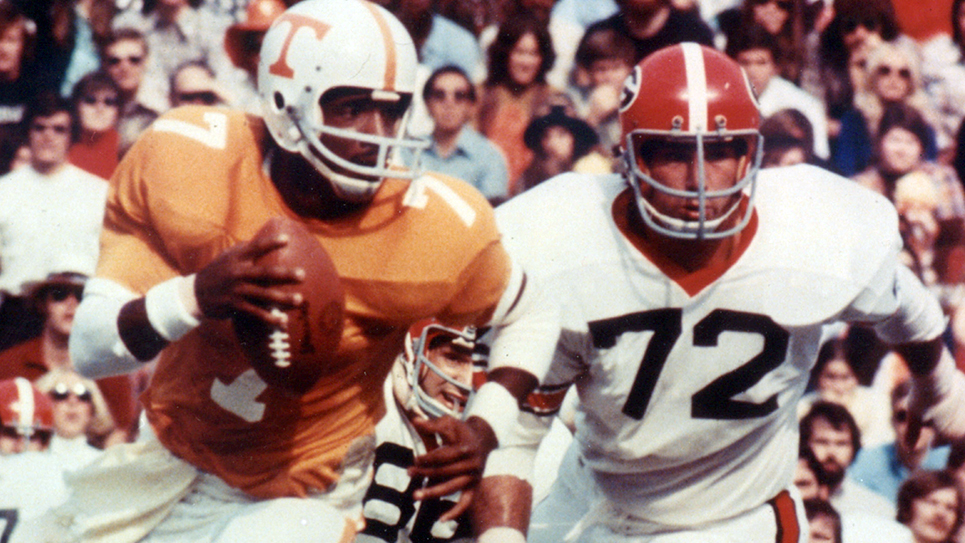By Tom Mattingly
When the Football Writers Association of America selected a Quarter Century All-SEC team for the years 1950-74 in December 1975, the only unanimous selection was Douglas Leon Atkins of Humboldt, Tenn., a legendary Vol from the years 1950 -52.
Not LSU’s Billy Cannon.
Not Tennessee’s John Majors.
Not Alabama’s Lee Roy Jordan.
Not Mississippi’s Archie Manning.
None of the usual suspects.
Atkins got the nod, as a towering presence on the defensive front for Gen. Bob Neyland at Tennessee, initially, and later for the Chicago Bears and head coach George Halas.
Atkins starred on Tennessee teams that compiled a 29-4-1 record and played in the Cotton Bowl twice (1951, 1953) and the Sugar Bowl (1952). He was a 1952 All-American selection, two-time All-SEC selection, and was selected to the All-Time SEC Team (1933-1982). The Vols were consensus national champions in 1951.
Atkins wore No. 91 on his orange and white jersey, playing at 6-6, 225, according to game programs from the 1952 season. Those who lined up against him would steadfastly maintain he was much bigger. And he probably was.
He was drafted by the Cleveland Browns in the first round of the 1953 Draft, playing for the Browns (1953-54), the Chicago Bears (1955-66), and the New Orleans Saints (1967-69). He was part of NFL championship teams in 1954 and 1963. He retired having played in 207 games, most ever by a defensive lineman to that time. He won the 1968 Vince Lombardi award for dedication to the game.
He was an eight-time Pro Bowl selection and member of the Pro football Hall of Fame’s All-1960s Team, playing then at 6-8, 275. He had a sack on the last play of his professional career.
He was part of the inaugural class of the Tennessee Sports Hall of Fame in 1966.
How good a player was Atkins, a member of the College and Pro Football Halls of Fame?
Here are a couple of opinions.
“Doug Atkins was like a storm blowing over a Kansas farm house,” intoned John Facenda of NFL Films in 1983.”He came from all directions. All there was to do was to tie down what you could and hope he didn’t take the roof.”
“He was just a vicious pass rusher,” said Pro Football Hall of Famer Mike Ditka, a former Bears teammate. “He’d take the tackle all the way back to the quarterback and knock them both down. He had a great wingspan. He just played the game hard, the way you were supposed to play it.”
There are times those 1950s college players, and even those who labored in the pros in the 1960s and 1970s, often get lost in today’s sports milieu, when anything that happened before 1990 is considered suspect.
Too long ago, the critics say.
Football’s a different game, they add.
There was, however, some good football played in those days on Saturday and Sunday afternoons.
Shields-Watkins Field was a center of activity for Atkins, before he moved to Cleveland Stadium, Wrigley Field, and Tulane Stadium.
Those venues were Doug Atkins’ canvas, where he plied his trade and moved ever onward to football immortality. He made life miserable for opposing offensive linemen and quarterbacks. Coaches tried, nearly often in vain, to get away from Atkins. He was that good, playing from sideline to sideline and occasionally dropping into pass coverage near the line of scrimmage.
“One of his favorite tricks was to throw a blocker at the quarterback,” Johnny Unitas said.
Former Vol Bill Anderson told of going against Atkins when he was trying to make the cut for the Washington Redskins. Bill told Atkins he was from Tennessee and was just trying to make the team.
Atkins put up little resistance, and Anderson had a field day. When the other tight end came into the game, Atkins turned on the jets and dominated the proceedings. That was enough for Anderson to make the team, given the way his coaches thought be had “handled” Atkins.
For teammate Jim Haslam, captain of the team in Atkins’ senior season, one thing is certain when you’re talking about Doug’s Tennessee career: “His place in Tennessee football history is secure.”







